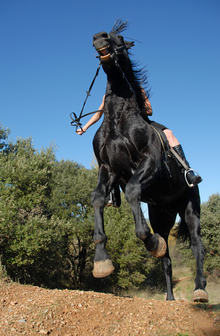The Western States Trail Ride, popularly called the Tevis Cup Ride, is the oldest modern day endurance ride In 1955, the late Wendell T. Robie with a party of five horsemen rode the Western States Trail from Squaw Valley to Auburn, proving that horses could cover 100 miles in one day.
This year's race will take place on August 4, when more than 200 horses meet at Robie Park, named after the founder of the race, near Lake Tahoe, California for the 100 mile endurance race to Auburn, California.

Trail = Test of horse and rider endurance
The Tevis Cup Ride is sanctioned by the American Endurance Ride Conference and has become the source of much needed research related to the endurance of horses and riders.
Along the way, a team of veterinarians and vet techs will be taking blood samples and checking the condition of the horses, gathering information to be analyzed to help determine the effects of the race on both horse and rider.
Through his energy and vision, Robie founded the Western States Trail Foundation and organized the annual Western States Trail Ride, also known as the Tevis Cup "100 Miles - One Day" Ride.
Robie continued to hold the ride annually and organized the Western States Trail Foundation to preserve the 100 mile trail and the Ride.
The Ride is sanctioned by the American Endurance Ride Conference and has become the source of much needed research related to the endurance of horses and riders.
Each rider who completes the 100 mile course from Tahoe to Auburn within the 24 hour limit and whose mount is judged "fit to continue" is awarded the coveted silver Completion Award Buckle.
The Tevis Cup trophy is awarded to the person who completes the 100-Mile One-Day course in the shortest amount of time and whose horse is in sound condition and "fit to continue." The Tevis Cup was named for Lloyd Tevis (1824 - 1899) by his grandson Will Tevis, a prominent San Francisco businessman and early benefactor of the Ride, and was first awarded in 1959 to Nick Mansfield, riding Buffalo Bill, an eleven year old TB Cross gelding.
The other major trophy, the Haggin Cup, is awarded to the rider whose horse is in the "most superior physical condition" of the first ten horses to cross the finish line. The Haggin Cup, named for James Ben Ali Haggin (1821 - 1914), was first awarded in 1964 to Paige Harper, riding his six year old Arabian gelding, Keno.
Over the past few years, research into the effects of endurance riding on horses, as well as riders has become an important part of the endurance race. For example, the characterization of average condition scores and weight loads in the endurance horses has been studied. Also, quantifying and evaluating the effects of condition score, body weight of horse and rider, and cannon bone circumference on athletic performance during endurance exercise has been studied
Results of studies have confirmed that rider weight, either independent of, or relative to the horse's body weight is not a critical factor in predicting performance during a 160-km endurance competition.
Body weight was also determined not to be a factor in horses disqualified for metabolic failure, but it did have an effect on lameness.
Complete blood count did not have a direct effect on performance, but the relatively narrow range of measurements obtained may be a contributing factor to lameness as body weight increased. However, body condition score has a strong effect on completion rate.
Since the Tevis Cup is a technically challenging event over unique terrain, further research into endurance and everything from the best horse shoe to the best tack for competitions is being evaluated and researched.
The Western States Trail Ride has partnered with Drs. Gary Magdesian, Langdon Fielding, head treatment veterinarian, and Greg Fellers, head veterinarian, to conduct field research at the first one hour stop in this year’s event. One of the missions of the WSTF is to contribute to veterinary research as part of their charter.
This unique and groundbreaking 2-year study project will generate data that will benefit future endurance competition and save lives.
Preliminary research has described potential blood tests that can identify endurance horses that may be compromised during the progression of an endurance ride. The Western States 100 mile ride is one of the most difficult endurance rides with the highest rate of metabolic failure.
This identification of horses at risk could improve completion rates and prevent injury. The objective this year is to create a metabolic score using basic blood electrolyte and hydration parameters that can be used to identify endurance horses that are metabolically compromised. The data from these two years will be used to create and validate the scoring system. Its implementation could then be used to help riders and veterinarians prevent illness and injury.
During 2012, laboratory results from the blood samples will not not be available to riders or to control veterinarians. Only in cases of a life-threatening emergency will the results from a sample be disclosed to the head veterinarian. Results of the testing will be provided to all riders with the return of their rider card at the end of the endurance race.
